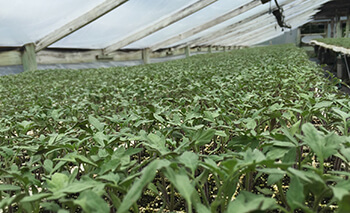Tomato Growing Tips
May 11, 2020

It’s that time of year when tomato planting is started. Here are a few tips that might be beneficial for both home gardens and commercial operations.
Tomatoes do well in rich, well-drained, slightly acidic soil with a pH of 6.5 to 6.8. To determine pH, bring a soil sample to your local Co-op or your local Extension Service. If the soil is too acidic, add lime. If it’s too alkaline, add sulfur or composted organic matter. The soil sample will also give you a fertility recommendation. It is a good practice to put half the fertilizer down pre-plant then side-dress the rest.
Tomatoes also like full sun. Plant spacing will range from 18 to 24 inches in the row and 5 to 6 feet between the rows. This spacing allows light into the lower portions of the mature plants and improve air flow.
Whether you’ve started your own seedlings or have some grown by a commercial plant grower, tomatoes like warmth. Wait until soil temps are consistently over 60°F before planting outside. If the weather is still questionable, protect plants from cold with row covers or with mini greenhouse hoops. This year, this has been a challenge.
Pruning is critical. Tomato plants send out suckers — leaves that shoot out from the main stem. “Suckering” tomato plants, or removing these leaves, makes sense because it promotes air circulation, keeps down disease, and focuses the plant’s energy on growing fruit. Small leaves and tender stems can be pinched off with your fingers.
Whether you stake and tie or use cages, do something to hold plants up off the ground. Tomatoes will be cleaner and plants will also be healthier.
After that, you are ready to watch plants grow. Always keep an eye out for insects and diseases. I pesticide application may be needed to stop the spread of disease or insects. You can consult your local agronomist at Co-op to help identify these issuses.
For more information about growing tomatoes or any other garden vegetable, visit your local Co-op.
Tomatoes do well in rich, well-drained, slightly acidic soil with a pH of 6.5 to 6.8. To determine pH, bring a soil sample to your local Co-op or your local Extension Service. If the soil is too acidic, add lime. If it’s too alkaline, add sulfur or composted organic matter. The soil sample will also give you a fertility recommendation. It is a good practice to put half the fertilizer down pre-plant then side-dress the rest.
Tomatoes also like full sun. Plant spacing will range from 18 to 24 inches in the row and 5 to 6 feet between the rows. This spacing allows light into the lower portions of the mature plants and improve air flow.
Whether you’ve started your own seedlings or have some grown by a commercial plant grower, tomatoes like warmth. Wait until soil temps are consistently over 60°F before planting outside. If the weather is still questionable, protect plants from cold with row covers or with mini greenhouse hoops. This year, this has been a challenge.
Pruning is critical. Tomato plants send out suckers — leaves that shoot out from the main stem. “Suckering” tomato plants, or removing these leaves, makes sense because it promotes air circulation, keeps down disease, and focuses the plant’s energy on growing fruit. Small leaves and tender stems can be pinched off with your fingers.
Whether you stake and tie or use cages, do something to hold plants up off the ground. Tomatoes will be cleaner and plants will also be healthier.
After that, you are ready to watch plants grow. Always keep an eye out for insects and diseases. I pesticide application may be needed to stop the spread of disease or insects. You can consult your local agronomist at Co-op to help identify these issuses.
For more information about growing tomatoes or any other garden vegetable, visit your local Co-op.